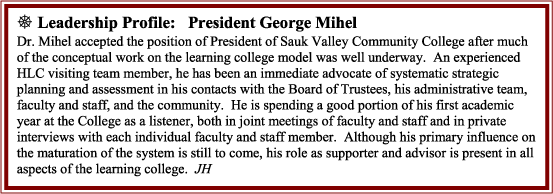Institutional Profile


Institutional Profile
- Location. Sauk Valley Community College is situated on a 163-acre campus in rural northwestern Illinois, along the scenic Rock River, midway between Dixon and the twin cities of Sterling and Rock Falls. The college district encompasses 1,466 square miles, serving portions of Bureau, Carroll, Henry, Lee, Ogle and Whiteside Counties-- a combined population of approximately 100,000 residents. The district is predominantly rural, with light manufacturing, agriculture, and steel production prominent in the region.
- History. Sauk Valley Community College is currently celebrating its 40th anniversary year of serving the region. The College was created by the citizens of Public Community College District #506 through public referendum in June 1965. The College was granted correspondent status with the North Central Association of Colleges and Secondary Schools in 1968 and granted accreditation in March of 1972.
- Services. Sauk provides a range of opportunities in the traditional vocational-technical fields; academic transfer areas; developmental, adult and continuing education; community service; and career education. Sauk's commitment to the public also includes intercollegiate athletics and cultural offerings. Sauk's commitment to serving the diverse needs of the district expresses itself in the existence of an array of support programs and technology services. ( See Appendix B for a description.) A visit to the Sauk website at www.svcc.edu will reveal the full array of services and opportunities the College offers the district. :
- Governance. The College is governed by a seven-member Board of Trustees elected by residents of the district and operating under the general supervision of the Illinois Community College Board. A student trustee, representing student interests, serves as a non-voting member of the Board. The chief executive officer of the College changed in June 2005 when the College's fourth president, Dr. Richard L. Behrendt, retired after serving the College for nineteen years. In May 2005, the Board of Trustees named Dr. George J. Mihel as the College's fifth president.

- Organization Chart.The Organization Chart (see Illustration
1), which was the primary accountability model during the
HLC accreditation team visit, has changed in two ways since 2002
that are significant for understanding the development of
assessment and strategic planning systems within a Learning college
model (see also Appendix
C):
- In the spring of 2004, retirement of the Vice President of Instructional Services resulted in a combination of that position with the position of Vice President of Student Services. The change, which partially responded to shrinking revenue resources, also integrated two vital service areas, enhancing the potential for communication and cooperation between the two areas.
- In the spring of 2005, a reorganization related to the resignation of the Director of Grants, Planning, and Institutional Research temporarily eliminated the position, the duties of which have been assumed by the Dean of Adult Educational Services. A permanent assignment of the planning responsibilities will be made after options are identified and considered.







